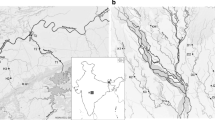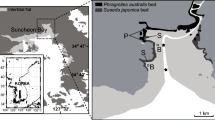Abstract
The food source utilization and trophic relationship of the fish assemblage in the Red River mangrove ecosystem, Vietnam were examined using dual isotope analysis. The carbon and nitrogen stable isotope signatures of 23 fish species ranged from −24.0 to −15.7‰ and from 8.8 to 15.5‰, respectively. Cluster analysis based on the δ13C and δ15N signatures clearly separated the mangrove fish into five feeding groups, representing detritivores, omnivores, piscivores, zoobenthivores, and zooplanktivores, which concurred with the dietary information. The results suggested that mangrove carbon contributed a small proportion in the diets of the mangrove fish, with dominant food sources coming from benthic invertebrates, including ocypodid and grapsid crabs, penaeid shrimps, bivalves, gastropods, and polychaetes. The δ15N values showed that the food web structure may be divided into different trophic levels (TLs). The lowest TLs associated with Liza macrolepis, Mugil cephalus, and Periophthalmus modestus; 18 fish species had TLs between 3.0 and 3.8; and Pennahia argentata had the highest TL (c. 4.0).



Similar content being viewed by others
References
Abrantes, K. & M. Sheaves, 2009. Food web structure in a near-pristine mangrove area of the Australian wet tropics. Estuarine, Coastal and Shelf Science 82: 597–607.
Baeck, G., T. Takita & Y. Yoon, 2008. Lifestyle of Korean mudskipper Periophthalmus magnuspinnatus with reference to a congeneric species Periophthalmus modestus. Ichthyological Research 55: 43–52.
Balan, V., 1967. Biology of the silverbelly, Leiognathus bindus (Val.) of the Calicut coast. Indian Journal Fish 10: 118–134.
Blaber, S., 2007. Mangroves and fishes: issues of diversity, dependence, and dogma. Bulletin of Marine Science 80: 457–472.
Bouillon, S., R. M. Connolly & S. Y. Lee, 2008. Organic matter exchange and cycling in mangrove ecosystems: recent insights from stable isotope studies. Journal of Sea Research 59: 44–58.
Cuong, D. N. & T. M. Khoa, 2004. Fish composition in the mangrove of northern communes of Giao Thuy district, Nam Dinh province. In Hong, P. N. (ed.), Mangrove Ecosystems in the Red River Coastal Zone: Biodiversity, Ecology, Socio-economics, Management and Education. Agriculture Publishing House, Hanoi: 121–125.
Elliott, M., A. K. Whitfield, I. C. Potter, S. J. M. Blaber, D. P. Cyrus, F. G. Nordlie & T. D. Harrison, 2007. The guild approach to categorizing estuarine fish assemblages: a global review. Fish and Fisheries 8: 241–268.
Froese, R. & D. Pauly, 2011. FishBase. World Wide Web electronic publication. Version 08/2011. http://www.fishbase.org.
Fry, B. & K. C. Ewel, 2003. Using stable isotopes in mangrove fisheries research − a review and outlook. Isotopes in Environmental and Health Studies 39: 191–196.
Giarrizzo, T., R. Schwamborn & U. Saint-Paul, 2011. Utilization of carbon sources in a northern Brazilian mangrove ecosystem. Estuarine, Coastal and Shelf Science 95: 447–457.
Koslow, J. A., 1981. Feeding selectivity of schools of northern anchovy, Engraulis mordax, in the Southern California Bight. Fishery Bulletin 79: 131–142.
Layman, C. A., 2007. What can stable isotope ratios reveal about mangroves as fish habitat? Bulletin of Marine Science 80: 513–527.
Lin, H.-J., W.-Y. Kao & Y.-T. Wang, 2007. Analyses of stomach contents and stable isotopes reveal food sources of estuarine detritivorous fish in tropical/subtropical Taiwan. Estuarine, Coastal and Shelf Science 73: 527–537.
Lugendo, B. R., I. Nagelkerken, G. Kruitwagen, V. D. V. Gerard & Y. D. Mgaya, 2007. Relative importance of mangroves as feeding habitats for fishes: a comparison between mangrove habitats with different settings. Bulletin of Marine Science 80: 497–512.
Mazumder, D., N. Saintilan, R. J. Williams & R. Szymczak, 2011. Trophic importance of a temperate intertidal wetland to resident and itinerant taxa: evidence from multiple stable isotope analyses. Marine and Freshwater Research 62: 11–19.
Michener, R. & K. Lajtha, 2007. Stable isotopes in ecology and environmental science, 2nd ed. Wiley-Blackwell, Oxford.
Nagelkerken, I., S. Blaber, S. Bouillon, P. Green, M. Haywood, L. G. Kirton, J. O. Meynecke, J. Pawlik, H. M. Penrose, A. Sasekumar & P. J. Somerfield, 2008. The habitat function of mangroves for terrestrial and marine fauna: a review. Aquatic Botany 89: 155–185.
Nanjo, K., H. Kohno & M. Sano, 2008. Food habits of fishes in the mangrove estuary of Urauchi River, Iriomote Island, Southern Japan. Fisheries Science 74: 1024–1033.
Nhuan, M. T., N. T. M. Ngoc, N. Q. Huong, N. T. H. Hue, N. T. Tue & P. B. Ngoc, 2009. Assessment of Vietnam coastal wetland vulnerability for sustainable use (Case study in Xuanthuy Ramsar Site, Vietnam). Journal of Wetlands Ecology 2: 1–16.
Nyunja, J., M. Ntiba, J. Onyari, K. Mavuti, K. Soetaert & S. Bouillon, 2009. Carbon sources supporting a diverse fish community in a tropical coastal ecosystem (Gazi Bay, Kenya). Estuarine, Coastal and Shelf Science 83: 333–341.
Odum, W. E. & E. Heald, 1972. Trophic analyses of an estuarine mangrove community. Bulletin of Marine Science 22: 671–738.
Parnell, A. C., R. Inger, S. Bearhop & A. L. Jackson, 2010. Source partitioning using stable isotopes: coping with too much variation. PLoS ONE 5(3): e9672.
Platell, M. E., H. P. Ang, S. A. Hesp & I. C. Potter, 2007. Comparisons between the influences of habitat, body size and season on the dietary composition of the sparid Acanthopagrus latus in a large marine embayment. Estuarine, Coastal and Shelf Science 72: 626–634.
Post, D. M., 2002. Using stable isotopes to estimate trophic position: models, methods, and assumptions. Ecology 83: 703–718.
R Core Team, 2012. R: a language and environment for statistical computing. R foundation for statistical computing, Vienna. ISBN 3-900051-07-0. http://www.R-project.org/.
Rodelli, M. R., J. N. Gearing, P. J. Gearing, N. Marshall & A. Sasekumar, 1984. Stable isotope ratio as a tracer of mangrove carbon in Malaysian ecosystems. Oecologia 61: 326–333.
Salameh, P., O. Sonin & D. Golani, 2010. First record of the burrowing goby, Trypauchen vagina (Actinopterygii: Gobiidae: Amblyopinae), in the Mediterranean. Acta Ichthyologica Et Piscatoria 40: 109–111.
Sheaves, M. & B. Molony, 2000. Short-circuit in the mangrove food chain. Marine Ecology Progress Series 199: 97–109.
Than, T. T., 2004. Composition of fish species at Tien Hai wetland Nature Reserve, Thai Binh province. In Hong, P. N. (ed.), Mangrove ecosystems in the Red River coastal zone: biodiversity, ecology, socio-economics, management and education. Agriculture Publishing House, Hanoi: 125–135.
Thimdee, W., G. Deein, C. Sangrungruang & K. Matsunaga, 2004. Analysis of primary food sources and trophic relationships of aquatic animals in a mangrove-fringed estuary, Khung Krabaen Bay (Thailand) using dual stable isotope techniques. Wetlands Ecology and Management 12: 135–144.
Tue, N. T., H. Hamaoka, A. Sogabe, T. D. Quy, M. T. Nhuan & K. Omori, 2011. The application of δ13C and C/N ratios as indicators of organic carbon sources and paleoenvironmental change of the mangrove ecosystem from Ba Lat Estuary, Red River, Vietnam. Environmental Earth Sciences 64: 1475–1486.
Tue, N. T., T. D. Quy, A. Amano, H. Hamaoka, S. Tanabe, M. T. Nhuan & K. Omori, 2012a. Historical profiles of trace element concentrations in mangrove sediments from the Ba Lat Estuary, Red River, Vietnam. Water, Air, & Soil Pollution 223: 1315–1330.
Tue, N. T., T. D. Quy, H. Hamaoka, M. T. Nhuan & K. Omori, 2012b. Sources and exchange of particulate organic matter in an estuarine mangrove ecosystem of Xuan Thuy National Park, Vietnam. Estuaries and Coasts 35: 1060–1068.
Tue, N. T., H. Hamaoka, A. Sogabe, T. D. Quy, M. T. Nhuan & K. Omori, 2012c. Food sources of macro-invertebrates in an important mangrove ecosystem of Vietnam determined by dual stable isotope signatures. Journal of Sea Research 72: 14–21.
Tue, N. T., N. T. Ngoc, T. D. Quy, H. Hamaoka, M. T. Nhuan & K. Omori, 2012d. A cross-system analysis of sedimentary organic carbon in the mangrove ecosystems of Xuan Thuy National Park, Vietnam. Journal of Sea Research 67: 69–76.
Wainright, S. C., M. J. Fogarty, R. C. Greenfield & B. Fry, 1993. Long-term changes in the Georges Bank food web: trends in stable isotopic compositions of fish scales. Marine Biology 115: 481–493.
Zanden, M. J. V. & J. B. Rasmussen, 1999. Primary consumer δ13C and δ15N and the trophic position of aquatic consumers. Ecology 80: 1395–1404.
Acknowledgments
The authors are grateful to staff of VNU University of Science, and the Xuan Thuy National Park and the Tien Hai Nature Reserve, Vietnam for their help with sampling. We express our sincere thanks to anonymous reviewers—Prof. Tokeshi and Dr. Todd W. Miller for their critical reviews and comments which significantly improved the manuscript. This work was partially supported by the “Global COE Program” from the Ministry of Education, Culture, Sports, Science and Technology, Japan and the Vietnam’s National Foundation for Science and Technology Development (NAFOSTED) (No 105.09.82.09). The Grant-in-Aid for Scientific Research for Postdoctoral Fellows by the Japan Society for the Promotion of Science (No. 24-02386 for NTT) is also acknowledged.
Author information
Authors and Affiliations
Corresponding author
Additional information
Guest editors: M. Tokeshi & H. T. Yap / Biodiversity in Changing Coastal Waters of Tropical and Subtropical Asia
Rights and permissions
About this article
Cite this article
Tue, N.T., Hamaoka, H., Quy, T.D. et al. Dual isotope study of food sources of a fish assemblage in the Red River mangrove ecosystem, Vietnam. Hydrobiologia 733, 71–83 (2014). https://doi.org/10.1007/s10750-013-1737-9
Received:
Accepted:
Published:
Issue Date:
DOI: https://doi.org/10.1007/s10750-013-1737-9




